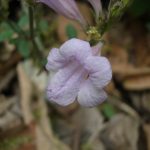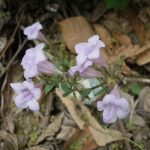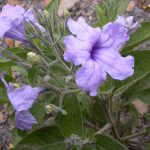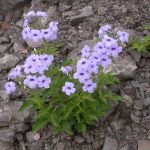.

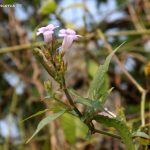

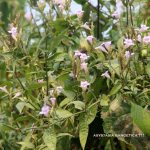
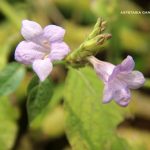
ASYSTASIA GANGETICA : MORE IMAGES
5 images.
There was a request to send more images of the plant. Attaching few more images for further confirmation.
I think it will be Ruellia ciliatiflora as per images and references herein.
I agree with …
May I request you to pl. confirm it as Ruellia ciliatiflora or otherwise.
This is not Ruellia ciliatiflora. I think it is probably a species of Asystasia (note club-shaped capsule) but I can only see two stamens. It is not Asystasia gangetica as far as I can see. Sorry not to be more definite.
After checking all species reported from India as per details at Asystasia, I found only option is to go for Asystasia nemorum as per GBIF– specimen 1, specimen 2 and specimen 3
I seek your kind help in the matter.
I guess it looks different from Asystasia nemorum as well.
Could it be some Strobilanthus species
Thanks, Lalithamba ji.
But Dr. Wood (Expert on Strobilanthes) indicated it to be Asystasia species only.
Not Strobilanthes!
I too agree with … for Asystasia,
resembles Asystasia chelnoides,
Thanks, …
I am unable to solve this mystery.
I agree with …
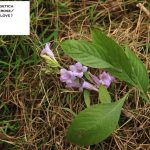
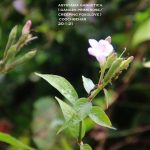
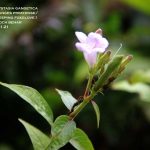
ASYSTASIA GANGETICA
3 images.
Attaching three images of Asystasia gangetica (Ganges Primerose/ Creeping Foxglove)
Hoping it’s not gangetica, …,
Could be dalzelliana,
You mean to say Asystasia dalzelliana Santapau …
Yes, …
Maybe Asystasia gangetica (L.) T.Anderson only as per comparative images at Asystasia
I think it will be Ruellia ciliatiflora as per images and references herein.
I think same as in ASYSTASIA GANGETICA : MORE IMAGES
.
Acanthaceae Fortnight : Dipteracanthus prostratus : Uttarakhand : 31MAR15 : AK-49 : 17 posts by 5 authors. Attachments (3)
This and my earlier post, both have been identified as being the same by …
Experts, kindly have a look.
How large are these flowers length total and width across the petals please
Member of Bignoniaceae, Incarvillea arguta kindly check
Dipteracanthus prostratus, identified by … should be the correct one, since he is familiar with the flora of that area.
- http://www.plantillustrations.org/species.php?id_species=892828
- http://www.botanicus.org/page/466430
Thank you
I am not an expert, and certainly not for Acanthaceae. I may have suggested similarity with D.prostratus. In fact I have not seen R.ciliatiflora.
An image of Ruillia ciliatiflora can be seen here.
Thank you very much Rawat Sir. I admit I was wrong guessing probability of R. ciliatiflora Hook. My guess was based on b/w illustration of plantillustrations.org and a herbarium; where flowers are in leafless panicle.
So, I fail to id this one..
This plant seems more closer to the ID suggested by … (R.ciliatiflora) than the ID suggested by me (Dipteracanthus prostratus) as it has terminal cluster of flowers than solitary axillary flower (as in D.prostratus). This species (R.ciliatiflora) is known in Uttarakhand.
The link for picture of R.ciliatiflora was added by me to further confirm the ID and not to rule out R.ciliatiflora. In the pics attached by … leaves are not visible.
The plant probably need a further examination by experts.
Thank you very much Sir for the feedback. Unfortunately I do not think R. ciliatiflora Hook. is viable. Because “Annals of the Missouri Botanical Garden, vol. 80: p. 811, fig. 11 (1993)” clearly states that Curtis’ coloured illustration is correct. It also informs R. ciliatifolia Hook. is closely related to R. nudiflora complex. The species feature 10 mm calyx, 3.5-4.5 cm corolla. I think … species has much smaller flower and doesn’t look like a member of R. nudiflora complex.
However, thank you very much for the discussion. At least now we have KEY and description of American Ruellia!
No, … i your plant is not R. ciliatiflora as I have stated in my previous mail sent minutes ago. Now, I would stress on Asystasia. You can see your flower has the form of A. gangetica. Don’t rely in google search of Asystasia. I spent quite some time on finding correct Asystasia images of various species in the net. There is lots of mix-up over the net. What has been marked as A. macrocarpa in certain flickr account has other wrongly identified species. A. macrocarpa should be similar to gangetica I think.
We need to dig more to identify this particular species. Because, I do not know if any other genus, say Strobilanthes can have similar species.
Maybe R. ciliatiflora Hook. as per discussions at Wild Flowers For ID : Uttarakhand : 140413 : AK-3
.
| |
Wild Flowers For ID : Uttarakhand : 140413 : AK-3 : Attachments (2 + 1). 7 posts by 4 authors.
Ruellia sp?
Ruellia is what came to my mind too.
even to me look like Ruellia, habit and leaf structure will help in correct id..
Hope it helps since leaves can be seen
Seems to me Dipteracanthus prostratus (Acanthaceae).
Ruellia prostrata Poir. ??
Pl. post high resolution images.
However, Catalogue of Life and POWO do not give any distribution in India.
Does it have distribution in Uttarakhand? GBIF showing around Gujrat only !
Here are the original images.
Can these images be of R. ciliatiflora Hook.?
2 images.

